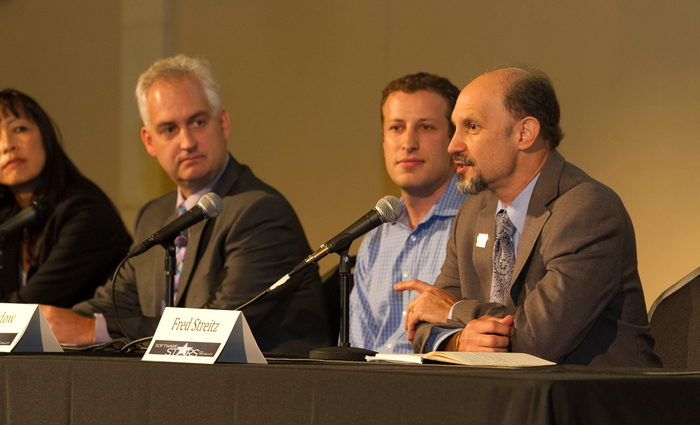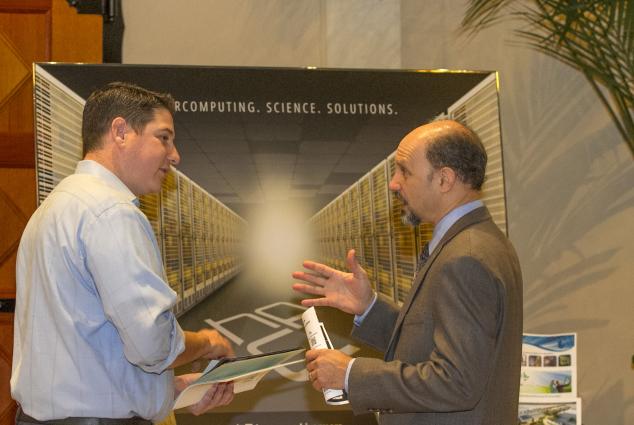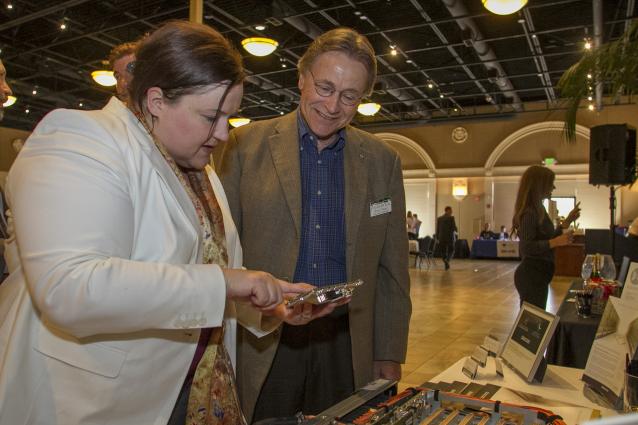Tri-Valley panelists discuss rise of computing
 (Download Image)
Fred Streitz, right, director of the High Performance Computing Innovation Center, participated in one of the forum's panels, "Software — Partnerships Key to an Innovative Ecology." Photos by Julie Russell/LLNL
(Download Image)
Fred Streitz, right, director of the High Performance Computing Innovation Center, participated in one of the forum's panels, "Software — Partnerships Key to an Innovative Ecology." Photos by Julie Russell/LLNL
Software development is rapidly transforming computing technology to the benefit of society, but the scarcity of "computing talent in the pipeline" impacts the pace of progress, a panel of computing experts concluded Thursday at Casa Real in Pleasanton.
The lunchtime discussion, under the title "Software — Partnerships Key to an Innovative Ecology," was part of the 7th Annual Innovation Forum, sponsored by the Innovation Tri-Valley Leadership Group. Moderating the event was Peter Burrows of Bloomberg News.
Panelists included Jackie Chen of Sandia National Laboratory, Rob Neely of Lawrence Livermore, Rob Sadow of the Pleasanton-based startup Scoop, and Fred Streitz, director of Lawrence Livermore’s High Performance Computing Innovation Center (HPCIC).
Neely, a deputy division leader in the Center for Applied Scientific Computing, talked about the critical need for new high performance computing (HPC) applications to deliver on the Lab’s national security missions, notably stewardship of the nation’s nuclear weapons.
The lab works closely with vendors to develop HPC systems, and extensive research in computational math is required to develop the applications that run on the machines, Neely said. "There are big changes coming to high performance computing and the software that drives these machines."
Streitz said that over the last two decades Lawrence Livermore has had a history of deploying what have often been the world’s largest supercomputers to fulfill the Lab’s national security mission, "and we anticipate that will continue for the foreseeable future."
"We’ve done some amazing things with computers of that capability," Streitz said, noting that the development of these HPC systems and their applications represents a "very rich" capability built on expertise from disciplines across the Laboratory.
"The purpose of the HPCIC is to expose that capability and those resources to Tri-Valley industry, California industry and to US companies in general to allow them to take advantage of these capabilities and see the innovation that results from cutting-edge computing."
The Innovation Tri-Valley Leadership Group focuses energy on expanding local economic development and bolstering the region’s role as a vital node in the Bay Area innovation system. Attracting talent to the region is a hot topic and the object of a collaborative effort by the leadership group, including strategic partners SNL and LLNL.
All panelists agreed that one of the biggest challenges they face is finding and attracting talent to meet the expanding needs of their research and development efforts.
"We’re in a growth period for software and computing. We’re actively hiring, but it’s a growth period for the entire Bay Area," said Neely, noting the Lab had the same issue in the 1990s dot.com era. "Everyone is having a hard time finding software talent. It’s a supply and demand problem. There are not enough graduates in the pipeline nationwide."
Salary pressures, housing prices and rents are "making it harder for people to move out here," he said.
Nonetheless, Neely said the proximity of Silicon Valley and the climate make Northern California an alluring option. "There’s cool technology at the Lab, it’s an attractive place to work and the Tri Valley is an attractive place to live."
Chen, a distinguished member of technical staff at Sandia’s Combustion Research Facility, agreed that it’s hard to attract talent, but noted that DOE offers programs for postdocs, interns and workforce development that allow the labs to attract and keep young talent. "The labs offer a different kind of R&D environment from industry and that resonates," she said.
Streitz expanded, "We offer the opportunity to work on problems you can’t touch anywhere else on Earth— whole different classes of problems and on scales that are rare, grand and highly impactful. That’s appealing to many."
Turning to the national picture for computing, Burrows asked the national lab panelists what impact the National Strategic Computing Initiative (NSCI), announced by President Obama July 29, would have on computing and the labs.
"We’re very excited to see this happen. It’s the first time this administration has made a clear statement that high performance computing is really important to the innovative capacity of this nation," Neely said.
He added that the global leadership in computing the nation has historically enjoyed is in good measure because of research at the national labs, "which push the boundaries of what can be done with computing. That trickles down to industry and the products we use every day."
NSCI also addresses some of the challenges faced by the computing community, including the dearth of talent, by tapping the National Science Foundation to lead a workforce development effort, Neely said. "There’s not enough talent in the university pipeline to drive the innovation in software and high performance computing that we need."
The initiative is intended to keep the United States at the forefront of HPC at a time of intense global competition when Europe, China, Russia and Japan "are nipping at our heels," Neely said. "We can’t take it for granted that those countries will continue to rely on U.S. technology to build these big machines."
In addition, NSCI recognizes the "explosive growth" of big data and the data sciences and the need to integrate with the simulation-based computing traditionally conducted at the labs, Neely said. "We think it will have a big impact on the funding for the kind of work we do at the labs."
"NSCI highlights the importance of HPC to the future of our country," Streitz said. "So much of our standard of living we owe to computation technology. We don’t even think about it. The phones in our pocket would have been a roomful of computers 30 years ago."
"For our children, the room full of computers we have today will be in their pocket in 30 years," he said. "Computation spurs an enormous amount of innovation that we in the US have taken for granted."
Contact
Don Johnston[email protected]
925-423-4902
Related Links
Innovation Tri-Valley Leadership GroupHigh Performance Innovation Center
Tags
HPC, Simulation, and Data ScienceHPC
Computing
HPC Innovation Center
Community Outreach
Featured Articles









